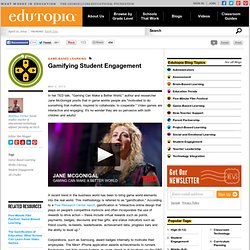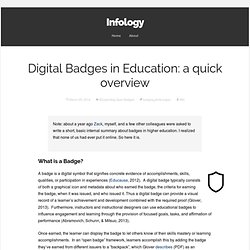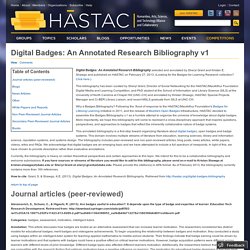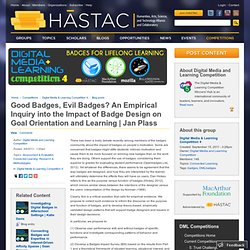

Open Badges. Badges What is a badge?

A badge is a symbol or indicator of an accomplishment, skill, competency, or interest. Badges can be used to represent achievements, communicate successes, and set goals. They can support learning that happens beyond traditional classrooms. Everything You Ever Wanted to Know About Badging in the Classroom: Our Definitive Guide. SmartBrief Exclusive Preview Everything You Ever Wanted to Know About Badging in the Classroom: Our Definitive Guide With new programs and standards emerging, digital badges are helping students prove what they've learned in--and outside--school.

By John K. Waters05/30/13 This article appears in the May 2013 issue of T.H.E. March was a big month in the world of digital badging. These developments signal the fast approach of a tipping point for digital badging in K-12 education. Grant works for the Humanities, Arts, Science, and Technology Advanced Collaboratory, better known as HASTAC (pronounced "haystack"), which administered the most recent MacArthur competition, the fourth such contest and the first to focus on digital badges. Why are all these organizations using their considerable weight to promote the development of digital badges? That idea seems central to the support digital badges are receiving from the Obama administration.
Badges and the Common Core. When today's K-12 students enter college and embark in their careers, they will most likely encounter a wide array of game-like elements, such as badge systems.

In June, Blackboard Learn, a learning management system for higher education, announced a partnership with Mozilla to support digital badges. In the corporate world, badge systems are also used to increase employee productivity. Mozilla's Open Badges Backpack serves as a virtual resume to display one's mastered skills. Gamifying Education One of the main goals of the Common Core State Standards (CCSS) is to prepare students for "college- and career-ready performance. " Game-based learning (GBL), like the CCSS, places a strong emphasis on mastering skills. GBL does not necessarily mean that students are simply playing video games in school. Creative Ways to Meet the Standards CCSS skill mastery can be acknowledged with a digital badging system. The CCSS only guide English language arts and math teaching. Using Badges in the Classroom to Motivate Learning. Free Web Tools Make Classroom Management Fun.
ClassDojo When I decided to become a teacher, the first course I took was on classroom management.

It involved all sorts of rubrics and checklists for documenting student behavior—certainly not the most fun aspect of the job, but a necessary one. The records that I learned to keep have come in handy over the years, especially for sharing with students’ parents when we meet to discuss their children’s work. Increasing Student Engagement By Grading Backwards. Good Morning.

You All Have An F: Increasing Student Engagement Via An Additive Grading System by Rob Steller, classxp.org In a way, the current education system is already set up like a game–just not a very well designed one. Gamifying Student Engagement. In her TED talk, "Gaming Can Make a Better World," author and researcher Jane McGonigal posits that in game worlds people are "motivated to do something that matters, inspired to collaborate, to cooperate.

" Video games are interactive and engaging. It's no wonder they are so pervasive with both children and adults! A recent trend in the business world has been to bring game world elements into the real world. This methodology is referred to as "gamification. " According to a Pew Research Center report, gamification is "interactive online design that plays on people's competitive instincts and often incorporates the use of rewards to drive action -- these include virtual rewards such as points, payments, badges, discounts and free gifts; and status indicators such as friend counts, re-tweets, leaderboards, achievement data, progress bars and the ability to level up. " Digital Badges in Education: a quick overview. Note: about a year ago Zack, myself, and a few other colleagues were asked to write a short, basic internal summary about badges in higher education.

I realized that none of us had ever put it online. So here it is. How Badges Can Increase User Engagement in MOOCs. Increase Engagement with Badges Moodle Moot 2014. Digital badges used to increase engagement. Digital Badges: An Annotated Research Bibliography v1. This annotated bibliography is a first step toward organizing literature about digital badges, open badges and badge systems.

This domain involves multiple streams of literature from education, learning sciences, library and information science, reputation systems, and systems design. The bibliography includes peer-reviewed and non peer-reviewed articles, blog posts, news articles, white papers, videos, wikis and FAQs. Are badges useful in education?: It depends upon the type of badge and expertise of learner. Good Badges, Evil Badges? An Empirical Inquiry into the Impact of Badge Design on Goal Orientation and Learning. There has been a lively debate recently among members of the badges community about the impact of badges on people’s motivation.

Some are concerned that badges might stifle students’ intrinsic motivation and cause them to be more focused on winning new badges than on the work they are doing. Others support the use of badges, considering them superior to grades for evaluating student performance (Openbadges List, 2012). Yet whatever the differences, there seems to be agreement that the way badges are designed, and how they are interpreted by the learner, will ultimately determine the effects they will have on users.
Dan Hickey refers to this as the purpose versus function of badges (Hickey, 2012), which mirrors similar ideas between the intentions of the designer versus the users’ interpretation of the design by Norman (1988). Connecting Badges and Expertise in Interest-Driven Affinity Spaces. As stated in the call for the 4th Annual Digital Media and Learning (DML) competition (Badges for Lifelong Learning), digital badges present an opportunity to design new systems in which “achievements are inspired, recognized, translated across contexts, and displayed and managed across the web.”

Already, it seems clear that the employment of effective badging systems could represent a critical focus for future digital media and learning innovation. In particular, badges can serve as both inspiration for future learning in informal learning environments, and as recognition of expertise in ways that are not easily captured with traditional means of assessment. And yet, as Halavais (2012) argues, "badging" necessitates ethical considerations; it is critical to understand how these systems have salience and are contested within the learning communities they serve. Method Work Plan Stage One: May, 2013 through September, 2013. Design-based Research Project: Who Built America? Teacher Mastery Badge System. HASTAC’s Digital Media and Learning Teacher Mastery award provides an opportunity to develop solutions for two commutual challenges in online teacher professional development (oTPD).
First, to create a sustainable online program that helps teachers learn new methods of promoting student inquiry and the practice of Common Core literacy skills, and that provides them with usable classroom materials. Insurgent_credentials__michael_olneck_2012.pdf.